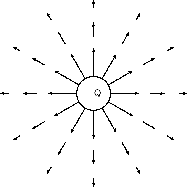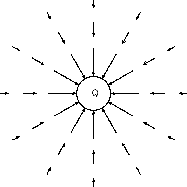| << Chapter < Page | Chapter >> Page > |
We have learnt that objects that carry charge feel forces from all other charged objects. It is useful to determine what the effectfrom a charge would be at every point surrounding it. To do this we need some sort of reference. We know that the force that onecharge feels due to another depends on both charges ( and ). How then can we talk about forces if we only have one charge? The solution to this dilemma is to introduce a test charge . We then determine the force that would be exerted on it if we placed it at a certain location. If we do this for everypoint surrounding a charge we know what would happen if we put a test charge at any location.
This map of what would happen at any point is called an electric field map. It is a map of the electric field due to a charge. It tells us, at each point in space, how large the force on a test charge would be and in whatdirection the force would be. Our map consists of the vectors that describe the force on the test charge if it were placed there.
A collection of electric charges gives rise to a 'field of vectors' in the surrounding region of space, called an electric field . The direction of the electric field at a point is the direction that a positivetest charge would move if placed at that point.
The electric field maps depend very much on the charge or charges that the map is being made for. We will start off with the simplest possible case.Take a single positive charge with no other charges around it. First, we will look at what effects it would have on a test chargeat a number of points.
Electric field lines, like the magnetic field lines that were studied in Grade 10, are a way of representing the electric fieldat a point.
At each point we calculate the force on a test charge, , and represent this force by a vector.

We can see that at every point the positive test charge, , would experience a force pushing it away from the charge, . This is because both charges are positive and so they repel. Alsonotice that at points further away the vectors are shorter. That is because the force is smaller if you are further away.
If the charge, Q, were negative we would have the following result.

Notice that it is almost identical to the positive charge case. This is important – the arrows are the same length becausethe magnitude of the charge is the same and so is the magnitude of the test charge. Thus the magnitude (size) of the force is the same. The arrows point in the opposite direction because thecharges now have opposite sign and so the positive test charge is attracted to the charge. Now, to make things simpler, we draw continuous lines showing the path that the test charge wouldtravel. This means we don't have to work out the magnitude of the force at many different points.

Notification Switch
Would you like to follow the 'Siyavula textbooks: grade 11 physical science' conversation and receive update notifications?